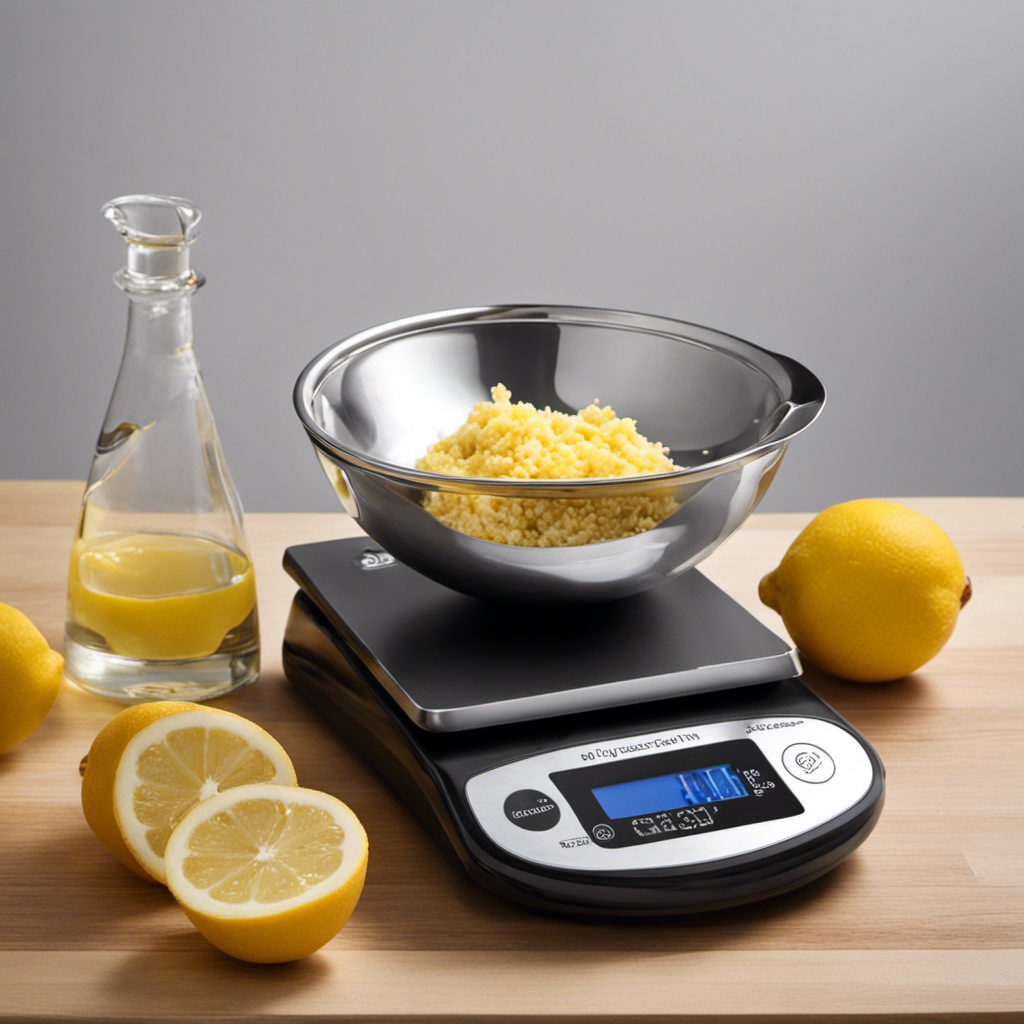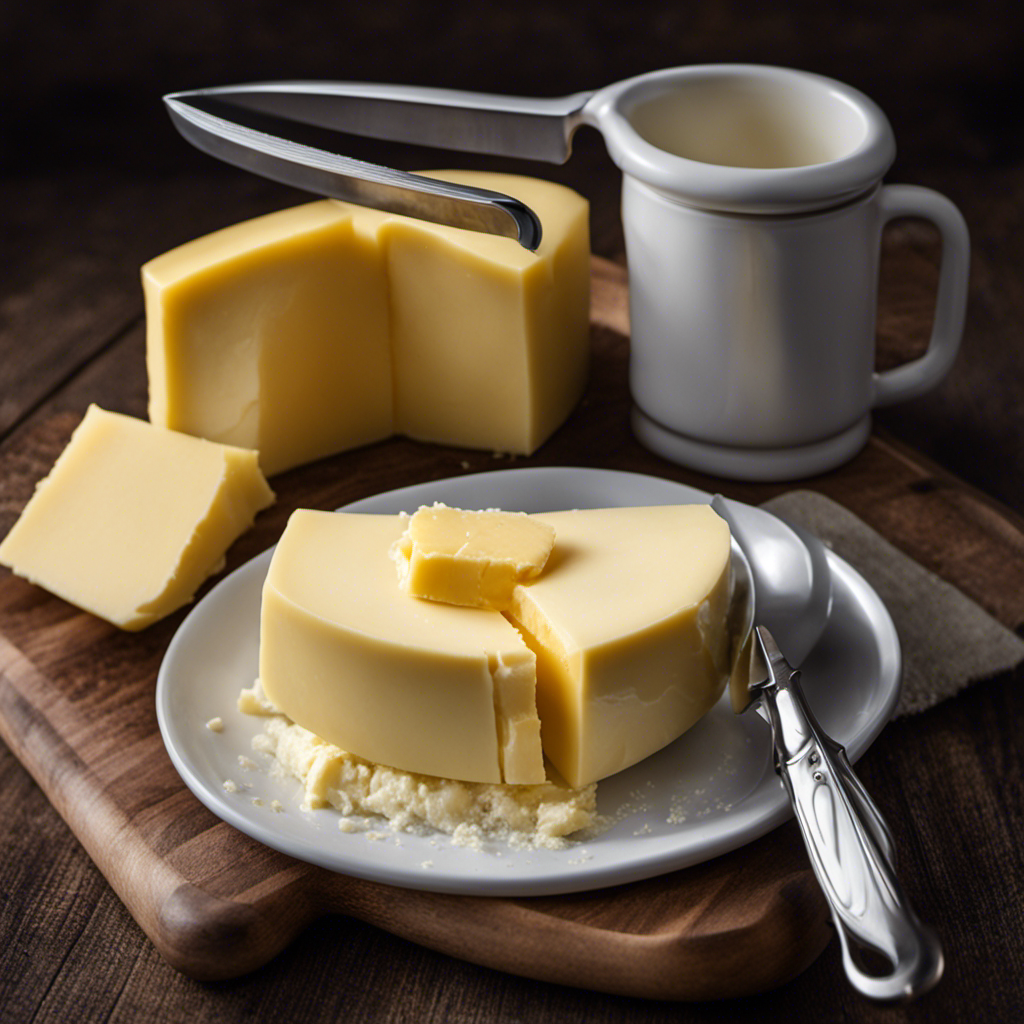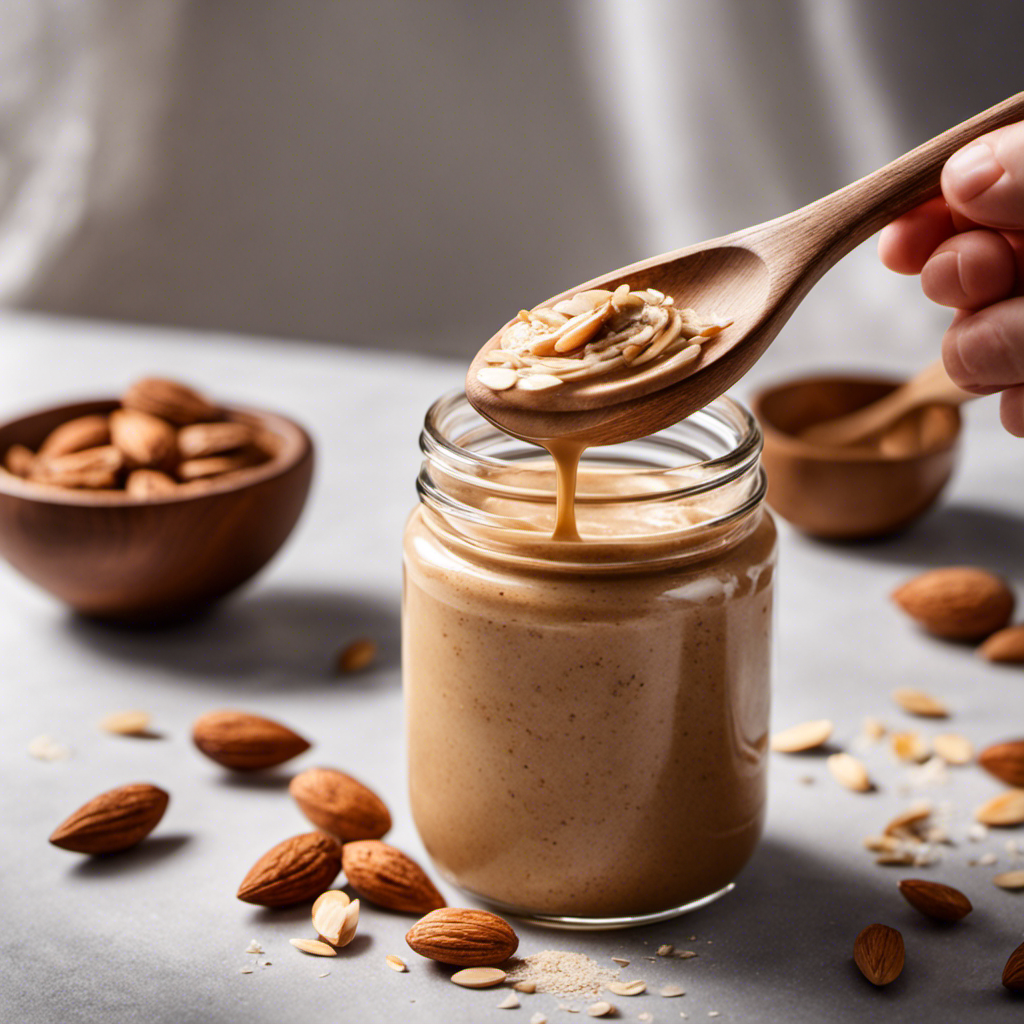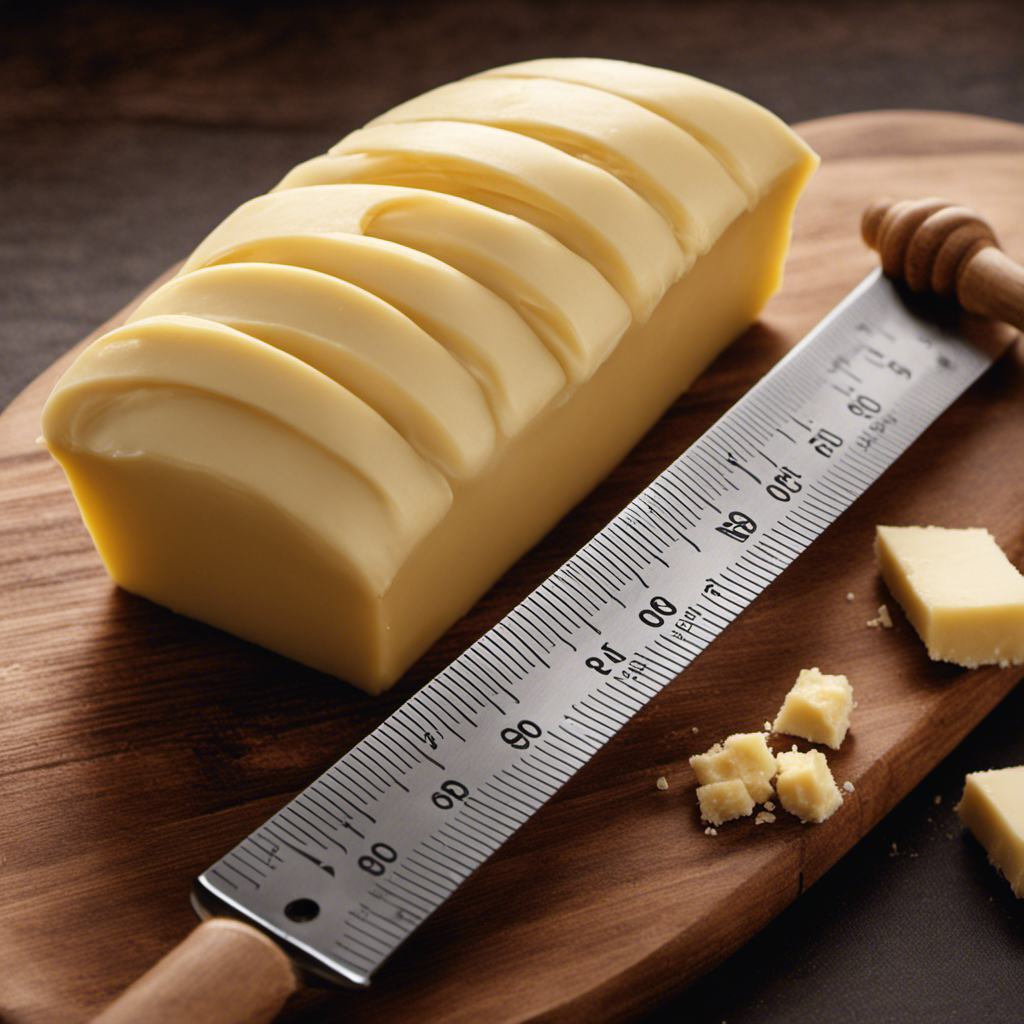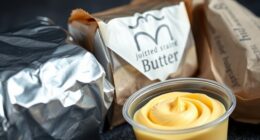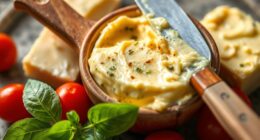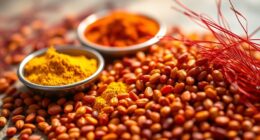Have you ever stopped to think about the weight of those two tablespoons of butter that can really enhance any dish?
In this article, I’ll be diving into the world of butter measurement, providing you with all the precise and informative details you need.
We’ll explore the conversion of tablespoons to grams, the difference between salted and unsalted butter, and how different types of butter can affect weight.
Get ready to become a butter measurement expert!
Key Takeaways
- Accurate measurement ensures proper proportions of fat and moisture in recipes.
- Converting tablespoons to grams involves converting tablespoons to milliliters and then multiplying by the density of butter.
- Salted butter weighs more than unsalted butter due to the addition of salt.
- Butter density varies based on fat content and production process. European-style butter has higher fat content, making it denser than regular butter.
Understanding the Importance of Measuring Butter
Understanding the importance of measuring butter is key when you’re trying to accurately follow a recipe. Accurate measurement of butter ensures that the proportions of fat and moisture in your recipe are just right, which can greatly affect the texture and taste of your final dish.
One common mistake in butter measurement is eyeballing it, which can lead to using too much or too little butter, resulting in a different outcome than intended. Another mistake is not properly softening the butter before measuring, which can throw off the measurement and impact the recipe.
To accurately measure butter, use a kitchen scale or refer to the measurement markings on the butter wrapper. It’s important to be precise when measuring butter to achieve consistent and delicious results in your cooking and baking endeavors.
The Basics of Butter Measurement
To get the basics of measuring butter, you can start by knowing how two tablespoons of it weigh. This knowledge is crucial when it comes to using butter in recipes or for dietary purposes.
Two tablespoons of butter weigh approximately 28 grams or 1 ounce. However, it is important to note that butter measurement conversions can vary depending on the country or region.
In the United States, butter is commonly sold in sticks, with each stick weighing 113 grams or 4 ounces. To convert measurements, it is helpful to know that one stick of butter is equivalent to 8 tablespoons or 1/2 cup.
Understanding these butter equivalents and measurement conversions will ensure accuracy in your cooking and baking endeavors.
Converting Tablespoons to Grams: A Quick Guide
Converting tablespoons of butter to grams is a quick and easy process. To understand the conversion, it’s important to know the density of butter, which is approximately 0.911 grams per milliliter. With this information, we can calculate the weight of butter in grams by converting tablespoons to milliliters and then multiplying by the density.
Here is a helpful table that illustrates the conversion for different amounts of tablespoons:
| Tablespoons | Milliliters | Grams |
|---|---|---|
| 1 | 14.79 | 13.47 |
| 2 | 29.57 | 26.94 |
| 3 | 44.36 | 40.41 |
| 4 | 59.15 | 53.88 |
| 5 | 73.93 | 67.35 |
As you can see, 2 tablespoons of butter is equivalent to 29.57 milliliters and weighs approximately 26.94 grams. This information will be useful when we further explore the weight of 2 tablespoons of butter in ounces.
The Weight of 2 Tablespoons of Butter in Ounces
As you can see, 2 tablespoons of butter is equivalent to 29.57 milliliters and weighs approximately 26.94 grams. This information will be useful for determining the weight in ounces.
Converting tablespoons to pounds can be done by first converting tablespoons to grams, and then converting grams to pounds. To convert grams to pounds, divide the weight in grams by 453.59237.
However, it’s important to note that the accuracy of butter measurements can be affected by temperature. Butter tends to soften and become more spreadable at room temperature, which can affect its weight.
To ensure accurate measurements, it’s recommended to use butter that is at the same temperature as specified in the recipe. Taking temperature into account will help in obtaining precise and consistent results when converting tablespoons of butter to pounds.
Is There a Difference Between Salted and Unsalted Butter
There’s a noticeable difference between salted and unsalted butter in terms of taste. But did you know that salted butter actually weighs more than unsalted butter? It’s true!
The addition of salt affects the weight of butter. Salt acts as a preservative and also adds flavor to the butter. However, it also adds weight. The amount of salt present in salted butter can vary, but on average, it can increase the weight by about 2-3%.
This means that if you were to weigh 2 tablespoons of salted butter and 2 tablespoons of unsalted butter, you would find that the salted butter weighs slightly more. So, if you’re watching your portion sizes or following a recipe that requires precise measurements, it’s important to take this difference into account.
How Different Types of Butter Affect Weight
Did you know that different types of butter can have varying effects on weight? The density of butter can differ depending on factors such as its fat content and the production process. For example, European-style butter tends to have a higher fat content, making it denser than regular butter. This means that if you were to measure the same volume of European-style butter and regular butter, the European-style butter would weigh more.
Additionally, the packaging of butter can also impact its weight. Butter sold in tubs or containers may have a higher water content, resulting in a lighter weight compared to butter sold in blocks or sticks. Understanding the variations in butter density and packaging can help you make more accurate measurements when cooking or tracking your calorie intake.
Speaking of measurements, let’s now explore a practical approach to measuring butter in sticks.
Measuring Butter in Sticks: A Practical Approach
In my previous discussion on different types of butter and their effect on weight, I explored how factors such as moisture content and packaging can impact the weight of butter. Now, let’s delve into a practical approach for measuring butter in sticks. While tablespoons are commonly used for measuring small amounts of butter, some recipes may call for butter to be measured in cups. To help you convert between the two, here’s a handy table:
| Butter Measurement | Sticks of Butter | Cups of Butter |
|---|---|---|
| 1 stick | 1 | 0.5 |
| 2 sticks | 2 | 1 |
| 3 sticks | 3 | 1.5 |
| 4 sticks (1 pound) | 4 | 2 |
| 8 sticks (2 pounds) | 8 | 4 |
While measuring butter in sticks is convenient, it’s important to note that alternative methods for butter measurement, such as using a kitchen scale, can provide more precise results.
Tips and Tricks for Accurate Butter Measurement
When it comes to measuring butter without scales, there are a few handy tricks I’ve discovered.
One method is to use tablespoons as a unit of measurement, but it’s important to know how to convert tablespoons to grams for accuracy.
Measuring Butter Without Scales
It’s helpful to know how to measure butter without scales. When you don’t have a scale on hand, here are some alternative methods for estimating the weight of butter:
-
Eyeballing Method:
-
Compare the size of the butter to a reference object, like a poker chip, which weighs around 1 ounce (28 grams).
-
Estimate the weight based on the size and density of the butter.
-
Volume Measurement:
-
Use measuring spoons to measure the butter in tablespoons.
-
Each tablespoon of butter is approximately 14 grams or 0.5 ounces.
While these methods may not be as precise as using a scale, they can give you a good estimate when you need to measure butter without scales. Remember to adjust your measurements based on your desired recipe and the accuracy you require.
Converting Tablespoons to Grams
To convert tablespoons to grams, you can multiply the number of tablespoons by approximately 14 grams. This is a simple and effective way to convert butter measurements, allowing you to easily determine the weight of a specific amount of butter. Here is a table to help illustrate the conversion:
| Tablespoons | Grams |
|---|---|
| 1 | 14 |
| 2 | 28 |
| 3 | 42 |
| 4 | 56 |
Frequently Asked Questions
Can I Use Margarine Instead of Butter for This Recipe?
Yes, you can substitute margarine for butter in this recipe. However, be aware that margarine has a different texture and flavor compared to butter, which may affect the overall taste and outcome of the dish.
How Do I Measure the Weight of Butter Without a Scale?
Measuring butter without a scale can be a challenge, but don’t worry! There are alternative ways to measure butter weight. Let me share some precise and informative methods with you.
Does the Temperature of the Butter Affect Its Weight?
Using ghee instead of butter may alter the flavor and texture of the recipe. When measuring melted butter, it is important to note that its weight will be different than solid butter due to the change in density.
Does Using Salted Butter Instead of Unsalted Butter Affect the Weight of the Butter?
Using salted butter instead of unsalted butter does not affect its weight. However, the water content in butter can vary, which may slightly change the weight.
Can I Substitute Oil for Butter in This Recipe and Still Get the Same Weight Measurement?
Substituting ghee for butter or using coconut oil instead of butter may affect the weight measurement. The weight of 2 tablespoons of butter can vary depending on the type and density of the substitute used.
Conclusion
In conclusion, measuring butter accurately is crucial when it comes to baking and cooking. Just like a conductor leading an orchestra, precise measurement ensures the perfect harmony of flavors in your culinary masterpiece.
Whether you’re converting tablespoons to grams or determining the weight of two tablespoons of butter in ounces, precision is key. Don’t forget to consider the differences between salted and unsalted butter, as well as the varying weights of different types of butter.
Remember, measuring butter in sticks can be a practical approach too. So, embrace the art of accurate butter measurement and let your culinary creations sing!
